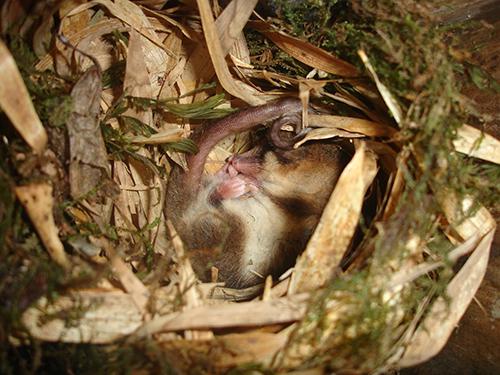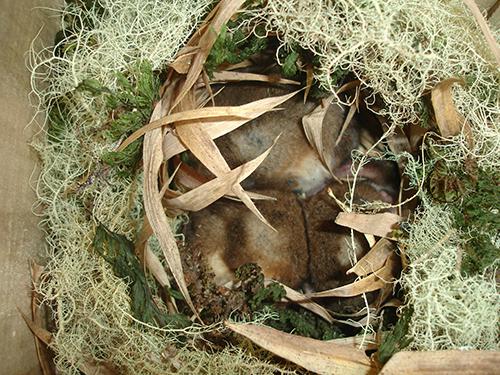Jennifer Ann Hetz Rodriguez
Huddling groups often include family members in many Australian marsupial species. However, while huddling occurs in the closely related Chilean species Monito del Monte (Dromiciops gliroides), kinship has not been thoroughly investigated. Evidence suggests that non-related juvenile individuals may huddle for warmth during winter because they have less time to gain the same fat reserves than adults, which is crucial to surviving lower temperatures and reduced food availability in winter. To test this hypothesis, we will analyse kinship between individuals nesting together during winter by examining the genetic structure of the population, which is critical to developing science-based conservation policies.

Dromiciops gliroides adult individual nesting alone during winter torpor in an artificial nest box. ©Jennifer Hetz.
To the date, several studies have shown that Dromiciops gliroides, Monito del Monte, exhibit facultative torpor when temperatures decline during the year and deeper torpor during the winter. This strategy, along with the use of nests for protection, the accumulation of fat in the tail, and a dense fur helps to preserve energy during winters. However, Dromiciops could also use another strategy to preserve heat. ‘Winter aggregations’ of 5 or more juvenile individuals have been described, suggesting that smaller animals could use huddling as an energy preservation strategy unlike adult individuals, that are more frequently found nesting alone during winter. Accordingly, huddling in Dromiciops may be a facultative response to external conditions similar to other mammal’s species that can change their behaviour quickly in response to environmental cues and adapt to new environmental conditions by forming, for example, non-kin huddling groups during winter to preserve energy. To help to answer this question, this project will evaluate if thermoregulation benefits are most likely to influence the formation of huddling groups between nonrelated juvenile individuals during winter in Dromiciops gliroides populations from Chiloé Island. Additionally, early in the reproductive season when mating occurs, females may form communal nesting groups with several nonrelated males to facilitate mating between individuals and increased quality of paternal genes. Thus, our results will not only help to clarify if nesting with strangers in Dromiciops may be a unique response to environmental stress but will also help to understand the mating system in this species. The analysis of kin relationships in Dromiciops gliroides winter huddling groups will:

Dromiciops gliroides winter huddling group in an artificial nest box. © Jennifer Hetz.
1. Increase knowledge of the adaptive value of huddling behaviour and the way in which it influences the biological fitness of the species.
2. Increase understanding of Dromiciops nesting behaviour and the significance of the use of tree hollows to help in the conservation of these nesting sites. This is of extreme importance because Dromiciops rely on tree-hollows for shelter and breeding; however, land-clearing has reduced their availability over the years.
3. Allow the investigation of dispersal dynamics and mating systems, which can help to implement in-situ and ex-situ management and conservation practices.